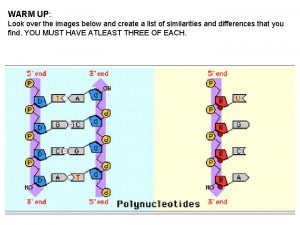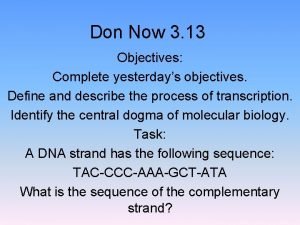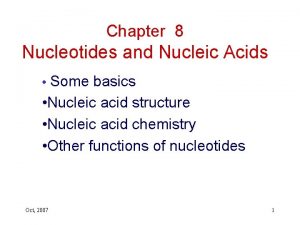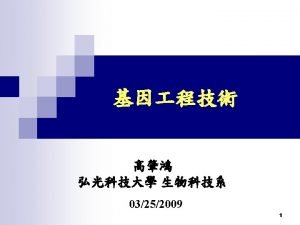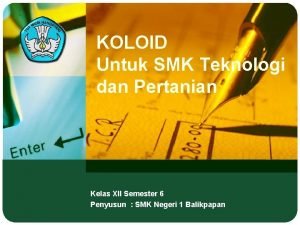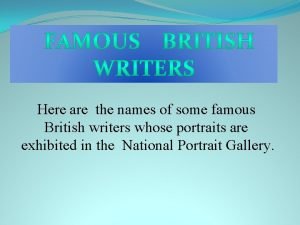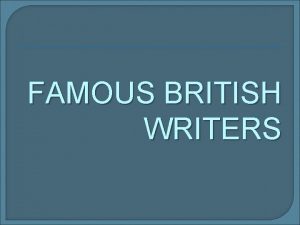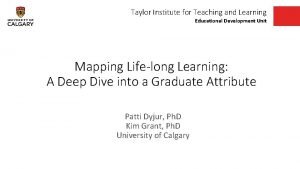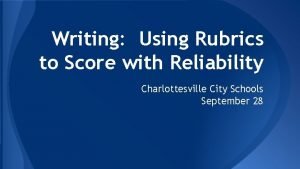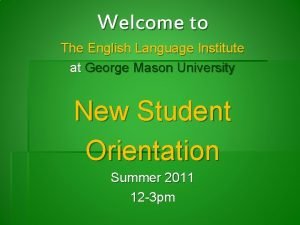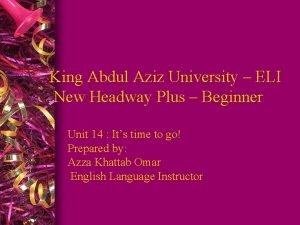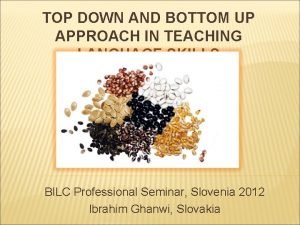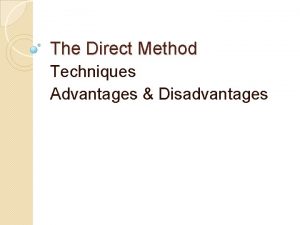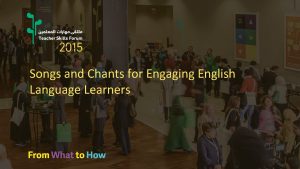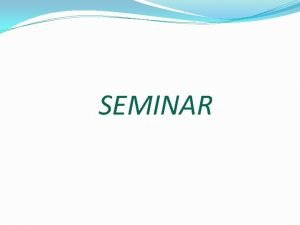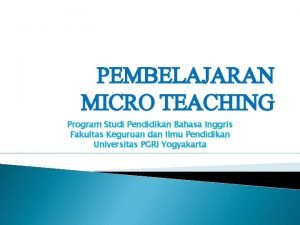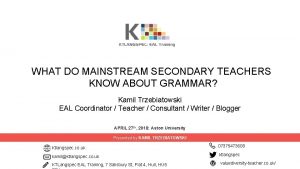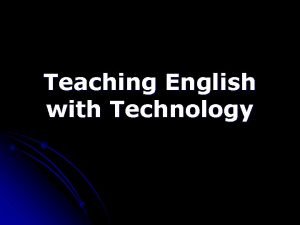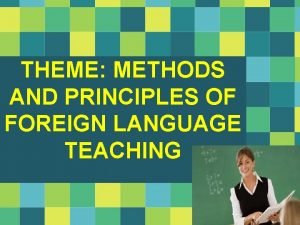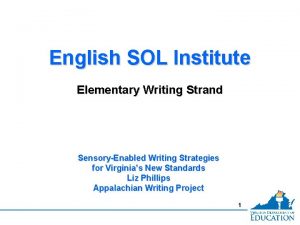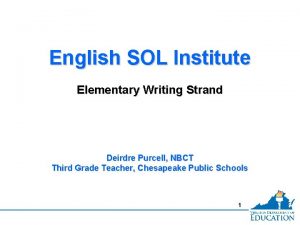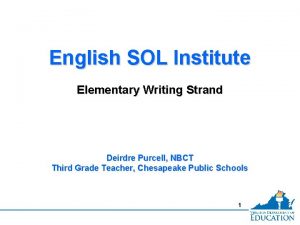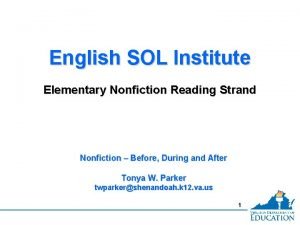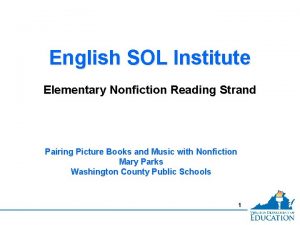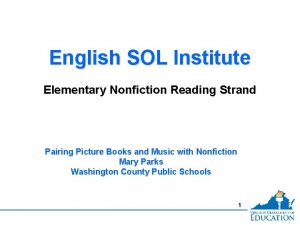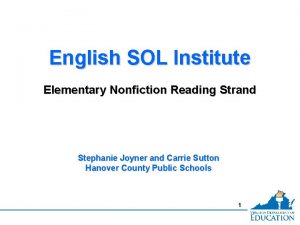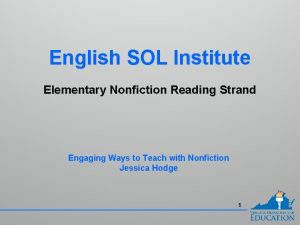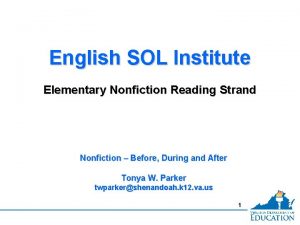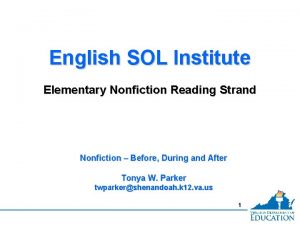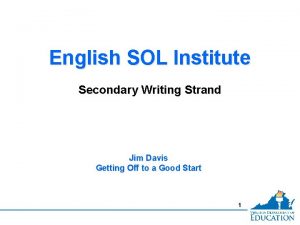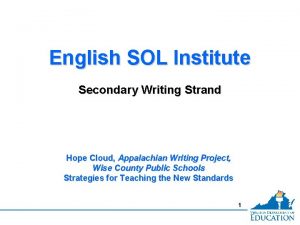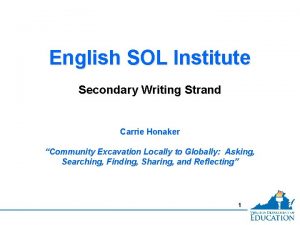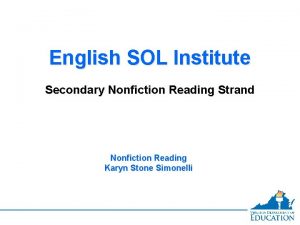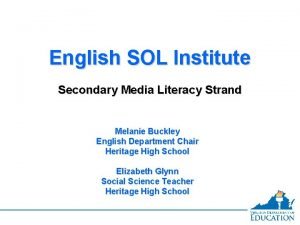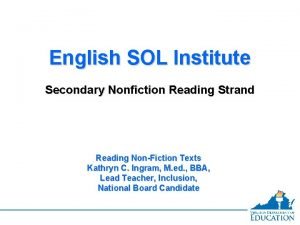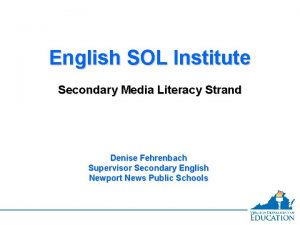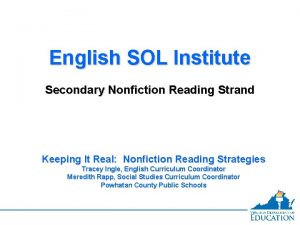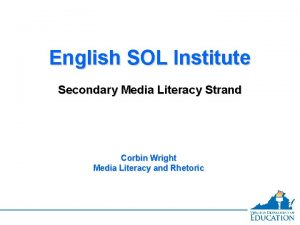English SOL Institute Elementary Writing Strand Teaching Writers
































- Slides: 32

English SOL Institute Elementary Writing Strand Teaching Writers in Grades K-5 Susan Swift, M. Ed. Middlesex County Public Schools 1

Elementary Writing Key Points in Writing • Writing to convey a concise message begins in Kindergarten and moves through grade 3 when students will write a short report • Student use of graphic organizers begins at grade 1 • Beginning in grade 4, students write multiparagraph essays 2

Elementary Writing Key Points in Writing • Persuasive writing begins in 5 th grade • Students in grades 3 -5 should have practice writing on demand, for shorter time frames, and over extended periods of time 3

“Every study of young writers I’ve done for the last twenty years has underestimated what they can do. In fact, we know very little about the human potential for writing. ” —Donald Graves, A Fresh Look at Writing (p. 99) 4

What memories do you have about writing during your elementary years? Did you have any positive experiences or memories that gave you confidence? Did you have any negative experiences that may have hindered your motivation/development? Take the next few minutes to reflect on this. Write down what comes to mind. Quickwrite – students are given a specific amount of time to quickly gather their thoughts about something. They record their thoughts and ideas on paper. 5

NCTE Beliefs about Writing People learn to write by writing. Writing is a process. Writing is a tool for thinking. Writing, reading, and speaking are related. Writing grows out of many different purposes. Conventions of finished and edited texted are important to reader. o Composing occurs in modalities and technologies. o Assessment of writing involves complex, informed human judgment. o o o 6

What do writers need? Students need: • to learn to write by writing. • a consistent approach – the writing process. • a direct and explicit instruction in writing. • models of good writing, from teachers and literature. • daily practice – time and opportunity. • formative feedback. • the opportunity to share their writing with others. 7

A Brief History: Writing Instruction during last 5 decades 1960 s: Traditional approach 1970 s: Shift to process 1980 s/1990 s: Inclusive of writer’s craft 2000 s/2010 s: Problem solving approach 8

Model of Gradual Release (R. Routman) Gradual Release of Responsibility (Pearson and Gallagher, 1993): Graphic 9

What does this model look like in Writing? • • • 10 The Writing Process Generating Ideas Prewriting Drafting Revising and Editing Sharing

“Writers don’t improve their craft unless they have a real purpose, a real audience, and a real investment in their writing. ” – Mem Fox 11

Kindergarten Writing K. 12 – Students will write for a variety of purposes, including narrative writing, informational writing, and functional writing Narrative: Write, dictate, and draw to narrate an event Informational: Write, dictate, and draw to state factual information Functional: Write, dictate, and draw to label things, make lists, and respond to literature 12

Kindergarten, continued Students should have assigned and self-selected topics Students share writing with others 1. Why draw? 2. Interactive Writing 3. Concepts about print 4. Continuum of writing development 13

What does Kindergarten Writing look like? 14

1 st Grade Writing 1. 13 Students will: generate ideas, use prewriting strategies write, revise, and edit written work write using a variety of formats, including narrative, informational, and functional writing The writing process is directly and explicitly taught: Generating ideas, prewriting using graphic organizers, drafting, revising, editing, final copies. Technology is utilized for writing and publishing. 15

1 st Grade Writing, continued Narrative writing includes an introduction, 2 events in sequence, and a conclusion Informational writing includes an introduction, some factual information, and a conclusion Functional writing includes lists, letters, reports, and messages Poetry is included Revision: Adding descriptive words, focusing on one topic, addressing comments of teachers and peers Editing: Complete sentences, begin sentences with a capital letter, capitalize I and proper nouns, spell sight words correctly 16

What does 1 st Grade writing look like? 17

2 nd Grade Writing 2. 12 The student will write stories, letters, and simple explanations. a) Generate ideas before writing. b) Organize writing to include a beginning, middle, and end for narrative and expository writing. c) Expand writing to include descriptive detail. d) Revise writing for clarity. Narrative writing includes a clear beginning, middle, and end. Students write simple and compound sentences. Students write declarative, interrogative, and exclamatory sentences. Revision also includes adding and deleting words. 18

What does 2 nd Grade Writing look like? 19

Two Domains of Writing Beginning in 3 rd grade, students need to be taught the elements of: Composing/Written Expression – how a writer relates a message, using organization, focusing on one topic, and how a writer uses language to reach audience: descriptive words, mood, voice, vocabulary Usage/Mechanics – Grammar, spelling, punctuation, capitalization, sentence structure 20

3 rd Grade Writing 3. 9 The student will generate ideas, use prewriting strategies using graphic organizers, talk to peers about writing, write narrative and informational pieces, revise, and edit writing. Students will identify their audience and purpose Teachers will incorporate mentor texts as a model for writing Organize writing according to form: Narrative, Informational (including reports), Letters, Poetry Students will write a short informational report, using the proper resources, and following the correct steps Students need to write on demand for short periods of time 21

What does 3 rd Grade writing look like? 22

4 th Grade Writing 4. 7 The student will write cohesively for a variety of purposes. a) Identify intended audience. b) Focus on one aspect of a topic. c) Use a variety of pre-writing strategies. d) Organize writing to convey a central idea. e) Recognize different modes of writing have different patterns of organization. f) Write a clear topic sentence focusing on the main idea. g) Write two or more related paragraphs on the same topic. h) Use transition words for sentence variety. i) Utilize elements of style, including word choice and sentence variation. j) Revise writing for clarity of content using specific vocabulary and information. k) Include supporting details that elaborate the main idea. Teachers will incorporate mentor texts as a model for writing. Students will write 2 or more paragraphs about one topic. Organize writing according to form: Narrative, Informational (including reports), Letters, Poetry Students will write a short informational report, using the proper resources, and 23 following the correct steps. Students need opportunities to write on demand for short periods of time.

What does 4 th Grade Writing look like? 24

5 th Grade Writing 5. 7 The student will write for a variety of purposes: to describe, to inform, to entertain, to explain, and to persuade. a) Identify intended audience. b) Use a variety of prewriting strategies. c) Organize information to convey a central idea. d) Write a clear topic sentence focusing on the main idea. e) Write multiparagraph compositions. f) Use precise and descriptive vocabulary to create tone and voice. g) Vary sentence structure by using transition words. h) Revise for clarity of content using specific vocabulary and information. i) Include supporting details that elaborate the main idea. 25

5 th Grade Writing • Students will write multiple paragraphs about one topic. • Organize writing according to form: Narrative, Informational (including reports), Persuasive, Letters, Poetry • Students need opportunities to write on demand for short periods of time. • Use technology to gather information, write, revise, edit, and publish writing. 26

What does 5 th Grade Writing look like? 27

Six Word Memoir Said to have originated with Hemingway Book: Not Quite What I Was Planning, Six Word Memoirs by Writers Famous and Obscure by Larry Smith and Rachel F AARP runs columns on specific topics, such as cheating death, best advice, love Ex: Cheating Death – “House on fire, pool below, jumped. ” (Helen G, 80) “Kidney from son. A life returned. ” (John G, 64) “Heart hurts! Hunky paramedics help. Hurray!” (Susan A, 61) 28

Six Word Memoir Not Quite What We Were Planning Six Word Memoirs by Mrs. Nixon’s 3 rd Grade Class (S. New Jersey) Two sisters. Two dogs. Life hard!!! Two sisters, one brother, equals fun. Love life most of the time. Nine years stacked within my soul. Eat, sleep, like to play sports. One class. Six words. What’s yours? 29

Let’s Write! Take a few minutes to think about writing and The Writing Process in grades K-5. How could you “sum it up” in a Six Word Memoir? Write for 3 minutes. 30

Contact Information Susan Swift, M. Ed. sswift@mcps. k 12. va. us

Disclaimer Reference within this presentation to any specific commercial or non-commercial product, process, or service by trade name, trademark, manufacturer or otherwise does not constitute or imply an endorsement, recommendation, or favoring by the Virginia Department of Education. 32
 Ring of fire
Ring of fire Mrna strand that is complementary to the dna strand aattgc
Mrna strand that is complementary to the dna strand aattgc Template strand, new strand, base pair, and dna polymerase.
Template strand, new strand, base pair, and dna polymerase. Phosphoanhydride bond
Phosphoanhydride bond Watson strand crick strand
Watson strand crick strand English language teaching institute
English language teaching institute Pemisahan koloid dengan cara penyaringan
Pemisahan koloid dengan cara penyaringan Famous british authors
Famous british authors Famous british writers
Famous british writers Taylor institute for teaching and learning
Taylor institute for teaching and learning Score charlottesville
Score charlottesville Microteaching meaning
Microteaching meaning George mason university english language institute
George mason university english language institute King abdulaziz university english language institute
King abdulaziz university english language institute Https://project.teachingenglish.org.uk
Https://project.teachingenglish.org.uk Innovative teaching methods in english
Innovative teaching methods in english Top down in reading
Top down in reading Advantages and disadvantages of the direct method
Advantages and disadvantages of the direct method Language
Language Bilingual method merits and demerits
Bilingual method merits and demerits Direct method of teaching english
Direct method of teaching english The direct method
The direct method How to teach english to arabic speakers
How to teach english to arabic speakers Materi micro teaching bahasa inggris
Materi micro teaching bahasa inggris Macam-macam evaluasi
Macam-macam evaluasi Microteaching lesson plan examples
Microteaching lesson plan examples Teaching young learners english
Teaching young learners english Substitution tables for teaching english
Substitution tables for teaching english Audio lingual method
Audio lingual method Teaching english with technology
Teaching english with technology Substitution table
Substitution table Principles of direct method of teaching english
Principles of direct method of teaching english Tagxedo
Tagxedo

